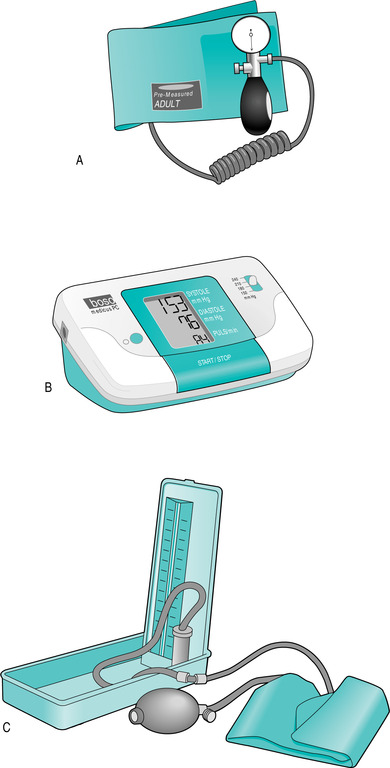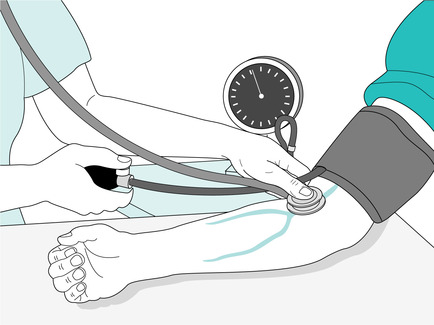Learning outcomes
By the end of this section, you should know how to:
▪ prepare the patient for this nursing practice
▪ collect and prepare the equipment
▪ assess, measure, and record blood pressure.
Background knowledge required
Revision of the anatomy and physiology of the cardiovascular system.
Indications and rationale for regarding blood pressure
Blood pressure is the force exerted by the blood as it flows through the bloodvessels. It is the arterial blood pressure that is normally recorded, and this may be indicated:
▪ to aid the diagnosis of disease
▪ to aid in the assessment of the cardiovascular system during and after disease
▪ to assess the efficacy of antihypertensive medication
▪ preoperatively to assess the patient’s usual range of blood pressure
▪ to aid in the assessment of the cardiovascular system following surgery or trauma.
 Equipment
Equipment |
| FIGURE 4.1Sphygmomanometers used for blood pressure measurementA Aneroid B Electronic C Mercury |
2. Blood pressure cuff: different-sized cuffs are available for use on a baby, a child or an obese person (Williams et al 2004)
3. Stethoscope (for use with only an aneroid or mercury sphygmomanometer)
4. Swabs to clean stethoscope ear pieces and diaphragm.
Sphygmomanometers
Because of the health and environmental hazards associated with the use of mercury, mercury sphygmomanometers are increasingly being phased out and replaced with aneroid or electronic sphygmomanometers to monitor patients’ blood pressure (Fig. 4.2). All sphygmomanometers should be calibrated at 6-monthly intervals by trained personnel to maintain the accuracy of the equipment (Williams et al 2004).
 |
| FIGURE 4.2Stethoscope over the brachial artery |
Should nurses encounter any sphygmomanometers that they have not previously used, competency in the use of the equipment must be assured before assessing any patient’s blood pressure.
▪ explain the nursing practice to the patient to gain consent and co-operation
▪ wash the hands to reduce the risk of cross-infection
▪ ensure the patient’s privacy to reduce anxiety and/or embarrassment
▪ collect the equipment to assist in the planning and implementation of the practice
▪ observe the patient throughout this activity to note any signs of distress
▪ help the patient into a suitable position, either sitting or lying, and remove any restrictive clothing from the arm. Avoid tightly rolled-up sleeves as these prevent constriction of the vessels of the limb immediately before the practice and may lead to an inaccurate recording.
Electronic sphygmomanometer
▪ follow the manufacturer’s instructions to achieving a recording, thus ensuring an accurate measurement
▪ continue the practice as for ‘All sphygmomanometers’, below.
Aneroid sphygmomanometer
Stay updated, free articles. Join our Telegram channel

Full access? Get Clinical Tree



